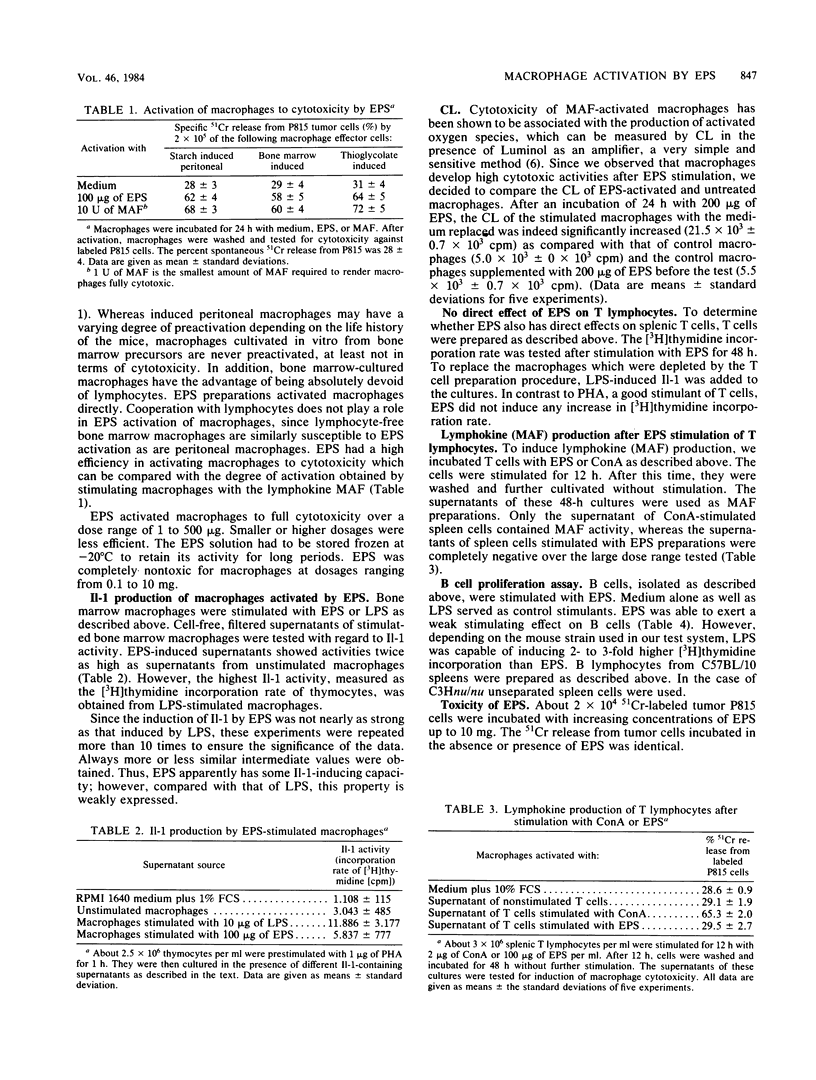Abstract
Purified polysaccharides (EPS) prepared from the plant Echinacea purpurea are shown to strongly activate macrophages. Macrophages activated with these substances develop pronounced extracellular cytotoxicity against tumor targets. The activation is brought about by EPS alone and is independent of any cooperative effect with lymphocytes. Also the production and secretion of oxygen radicals and interleukin 1 by macrophages is increased after activation with EPS. Cells of the macrophages lineage seem to be the main target for the action of these polysaccharides. EPS has no effect on T lymphocytes. B lymphocytes show a comparatively modest proliferation after incubation with E. purpurea EPS. Thus, these compounds, which are at least in tissue culture completely nontoxic, may be suited to activate in vivo cells of the macrophage system to cytotoxicity. They may therefore be of relevance in tumor and infectious systems.
Full text
PDF




Selected References
These references are in PubMed. This may not be the complete list of references from this article.
- Alexander P. The functions of the macrophage in malignant disease. Annu Rev Med. 1976;27:207–224. doi: 10.1146/annurev.me.27.020176.001231. [DOI] [PubMed] [Google Scholar]
- Bast R. C., Jr, Zbar B., Borsos T., Rapp H. J. BCG and cancer (first of two parts). N Engl J Med. 1974 Jun 20;290(25):1413–1420. doi: 10.1056/NEJM197406202902506. [DOI] [PubMed] [Google Scholar]
- Chedid L., Parant M., Parant F., Lefrancher P., Choay J., Lederer E. Enhancement of nonspecific immunity to Klebsiella pneumoniae infection by a synthetic immunoadjuvant (N-acetylmuramyl-L-alanyl-D-isoglutamine) and several analogs. Proc Natl Acad Sci U S A. 1977 May;74(5):2089–2093. doi: 10.1073/pnas.74.5.2089. [DOI] [PMC free article] [PubMed] [Google Scholar]
- Corbel C., Melchers F. Requirement for macrophages or for macrophage- or T cell-derived factors in the mitogenic stimulation of murine B lymphocytes by lipopolysaccharides. Eur J Immunol. 1983 Jul;13(7):528–533. doi: 10.1002/eji.1830130703. [DOI] [PubMed] [Google Scholar]
- Doe W. F., Henson P. M. Macrophage stimulation by bacterial lipopolysaccharides. I. Cytolytic effect on tumor target cells. J Exp Med. 1978 Aug 1;148(2):544–556. doi: 10.1084/jem.148.2.544. [DOI] [PMC free article] [PubMed] [Google Scholar]
- Galanos C., Freudenberg M. A., Reutter W. Galactosamine-induced sensitization to the lethal effects of endotoxin. Proc Natl Acad Sci U S A. 1979 Nov;76(11):5939–5943. doi: 10.1073/pnas.76.11.5939. [DOI] [PMC free article] [PubMed] [Google Scholar]
- Gery I., Krüger J., Spiesel S. Z. Stimulation of B-lymphocytes by endotoxin. Reactions of thymus-deprived mice and karyotypic analysis of dividing cells in mice bearing T 6 T 6 thymus grafts. J Immunol. 1972 Apr;108(4):1088–1091. [PubMed] [Google Scholar]
- Hahn H., Kaufmann S. H. The role of cell-mediated immunity in bacterial infections. Rev Infect Dis. 1981 Nov-Dec;3(6):1221–1250. doi: 10.1093/clinids/3.6.1221. [DOI] [PubMed] [Google Scholar]
- Juy D., Chedid L. Comparison between macrophage activation and enhancement of nonspecific resistance to tumors by mycobacterial immunoadjuvants. Proc Natl Acad Sci U S A. 1975 Oct;72(10):4105–4109. doi: 10.1073/pnas.72.10.4105. [DOI] [PMC free article] [PubMed] [Google Scholar]
- Mauel J. In vitro induction of intracellular killing of parasitic protozoa by macrophages. Immunobiology. 1982 Apr;161(3-4):392–400. doi: 10.1016/S0171-2985(82)80097-1. [DOI] [PubMed] [Google Scholar]
- Meerpohl H. G., Lohmann-Matthes M. L., Fischer H. Studies on the activation of mouse bone marrow-derived macrophages by the macrophage cytotoxicity factor (MCF). Eur J Immunol. 1976 Mar;6(3):213–217. doi: 10.1002/eji.1830060313. [DOI] [PubMed] [Google Scholar]
- Mizel S. B., Oppenheim J. J., Rosenstreich D. L. Characterization of lymphocyte-activating factor (LAF) produced by the macrophage cell line, P388D1. I. Enhancement of LAF production by activated T lymphocytes. J Immunol. 1978 May;120(5):1497–1503. [PubMed] [Google Scholar]
- Nelson D. S. Immunity to infection, allograft immunity and tumour immunity: parallels and contrasts. Transplant Rev. 1974;19(0):226–254. doi: 10.1111/j.1600-065x.1974.tb00134.x. [DOI] [PubMed] [Google Scholar]
- Ruco L. P., Meltzer M. S., Rosenstreich D. L. Macrophage activation for tumor cytotoxicity: control of macrophage tumoricidal capacity by the LPS gene. J Immunol. 1978 Aug;121(2):543–548. [PubMed] [Google Scholar]
- Wagner H., Proksch A., Riess-Maurer I., Vollmar A., Odenthal S., Stuppner H., Jurcic K., Le Turdu M., Heur Y. H. Immunstimulierend wirkende Polysaccharide (Heteroglykane) aus höheren Pflanzen. Vorläufige Mitteilung. Arzneimittelforschung. 1984;34(6):659–661. [PubMed] [Google Scholar]


